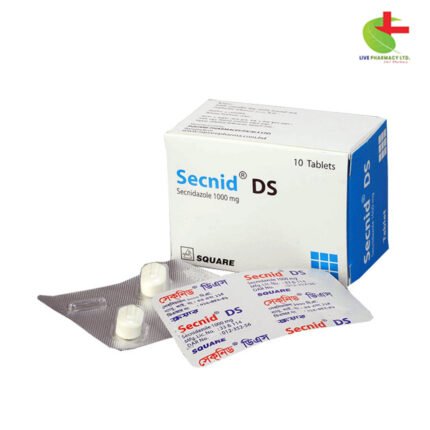Vigorex 25
100.30৳ Strip
- Vigorex is a powerful medication primarily prescribed for erectile dysfunction (ED) in men.
- It contains Sildenafil, a potent ingredient that enhances blood flow to the penis, facilitating firm and sustained erections during sexual activity.
- Additionally, Vigorex is indicated for the treatment of pulmonary arterial hypertension.
- With its rapid absorption and customizable dosing options, Vigorex offers an effective solution for improving sexual performance and quality of life in men with ED.
 Brand
Brand
|
Square Pharmaceuticals PLC |
|---|---|
 Generics
Generics
|
Sildenafil Citrate |
Indications
Vigorex is prescribed for the treatment of erectile dysfunction in men, characterized by the inability to achieve or sustain a penile erection sufficient for satisfactory sexual performance. It should be noted that sexual stimulation is necessary for Vigorex to be effective. Additionally, Vigorex is indicated for the treatment of pulmonary arterial hypertension.
Description
Vigorex operates as a selective, reversible inhibitor of cyclic guanosine monophosphate (cGMP)-specific phosphodiesterase type 5 (PDE5). Upon sexual stimulation, nitric oxide is released locally, leading to the inhibition of PDE5 by Vigorex, which subsequently elevates cGMP levels in the corpus cavernosum. This process results in smooth muscle relaxation and increased blood flow into penile tissues, facilitating erection. Importantly, Vigorex does not induce erections in the absence of sexual stimulation.
Pharmacology
Mechanism of Action: The physiological mechanism of penile erection involves the release of nitric oxide (NO) in the corpus cavernosum during sexual arousal. NO activates guanylate cyclase, leading to elevated levels of cyclic guanosine monophosphate (cGMP), which causes smooth muscle relaxation in the corpus cavernosum, allowing blood flow. Sildenafil, the active ingredient in Vigorex, enhances the effect of NO by inhibiting PDE5, which degrades cGMP. Consequently, when sexual stimulation triggers local NO release, PDE5 inhibition by Sildenafil increases cGMP levels, promoting smooth muscle relaxation and blood inflow, resulting in erection.
Pharmacokinetics and Metabolism: Sildenafil is rapidly absorbed after oral administration, with an average absolute bioavailability of 41%. It undergoes hepatic metabolism, primarily via cytochrome P450 3A4, forming an active metabolite with properties akin to the parent compound. Both Sildenafil and its metabolite have terminal half-lives of approximately 4 hours.
Absorption and Distribution: Sildenafil is quickly absorbed, with peak plasma concentrations reached within 30 to 120 minutes of oral intake in the fasting state. However, ingestion with a high-fat meal prolongs absorption.
Metabolism and Excretion: Hepatic microsomal isoenzymes clear Sildenafil. After oral or intravenous administration, Sildenafil is primarily excreted as metabolites in feces (about 80% of oral dose) and to a lesser extent in urine (approximately 13% of oral dose).
Pharmacokinetics in Special Populations: Elderly volunteers (65 years or older) exhibit reduced Sildenafil clearance, resulting in higher plasma AUC values compared to younger volunteers.
Dosage & Administration
For most patients, the recommended dosage of Vigorex for erectile dysfunction is 50 mg taken as needed, approximately 1 hour before sexual activity. However, it can be taken anywhere from 4 hours to 30 minutes before sexual activity. Based on efficacy and tolerability, the dose may be adjusted to a maximum of 100 mg or a minimum of 25 mg, with a maximum frequency of once per day.
Factors such as age (>65 years), hepatic impairment, severe renal impairment, and concomitant use of potent cytochrome P450 3A4 inhibitors may increase plasma Sildenafil levels, necessitating consideration of a lower starting dose.
For pulmonary arterial hypertension, the recommended dose is 20 mg of sildenafil citrate taken three times daily, approximately 4-6 hours apart, with or without food.
Interaction
Vigorex metabolism primarily involves cytochrome P450 (CYP) isoforms 3A4 and 2C9. Therefore, inhibitors of these isoenzymes may increase Vigorex concentrations, while inducers may decrease them. Coadministration with strong CYP3A4 inhibitors, such as ketoconazole or ritonavir, may significantly elevate Vigorex levels, necessitating dosage adjustment.
Contraindications
Vigorex is contraindicated in individuals with hypersensitivity to any component of the medication and in those using organic nitrates due to the potential for potentiation of hypotensive effects.
Side Effects
Common adverse reactions associated with Vigorex include facial edema, photosensitivity reactions, gastrointestinal discomfort, cardiovascular events, hematological abnormalities, musculoskeletal issues, nervous system disturbances, respiratory symptoms, skin reactions, and urogenital complications.
Pregnancy & Lactation
Vigorex is classified as pregnancy category B, indicating no evidence of teratogenic or embryotoxic effects in animal studies. However, its use is not recommended for women.
Precautions & Warnings
Physicians should exercise caution when prescribing Vigorex, especially in patients with preexisting cardiovascular conditions, bleeding disorders, active peptic ulceration, anatomical penile deformities, or conditions predisposing to priapism. Additionally, caution is warranted when coadministering Vigorex with alpha-blockers due to the potential for additive hypotensive effects.
Overdose Effects
In cases of overdose, supportive measures should be implemented as necessary. Renal dialysis is unlikely to accelerate Sildenafil clearance due to its high plasma protein binding and lack of urinary excretion.
Therapeutic Class
Vigorex belongs to the class of drugs for erectile dysfunction.
Storage Conditions
Store Vigorex in a dry place, away from light and heat, and out of reach of children.













Reviews
There are no reviews yet.